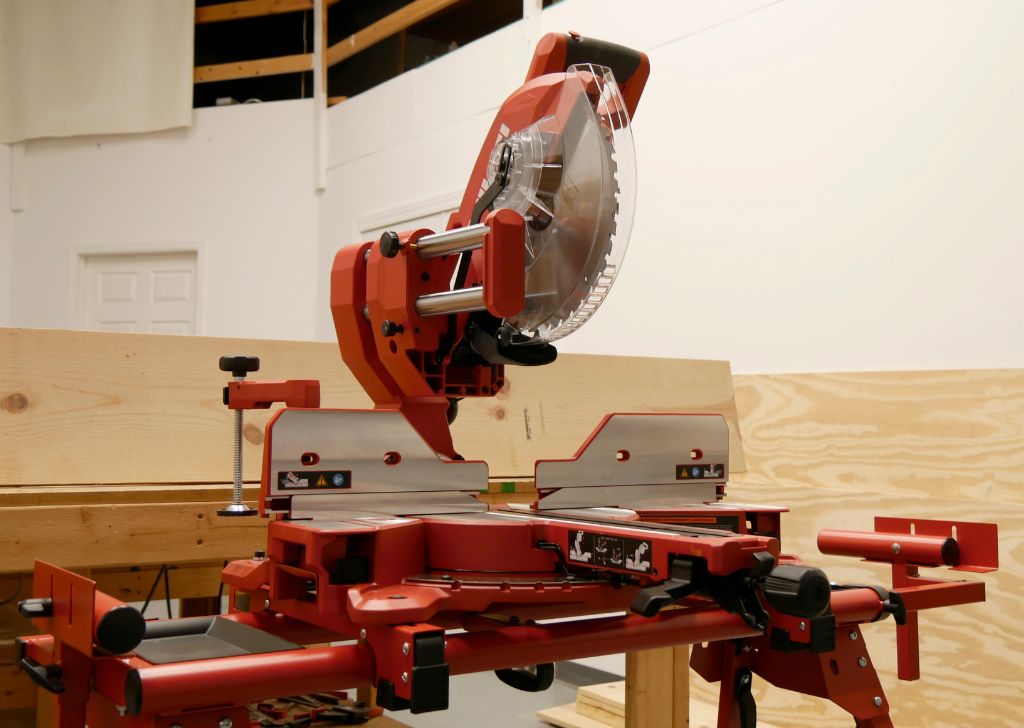What Is a Miter Saw?
A miter saw is a bench-mounted device designed to make fast, accurate crosscuts and angle cuts in wood, PVC, or even aluminum. You pull a spinning circular blade down onto the material, allowing you to cut cleanly through boards with control and precision. It’s one of the best options for making repeated cuts, especially when working with trim, framing, or decking.
Unlike a circular saw, which you guide through the cut, a miter saw brings the blade down into the workpiece. That makes it safer, faster, and more accurate when cutting angles and lengths.
History of the Miter Saw
The miter saw as we know it came to life in the 1960s, when Rockwell introduced the first power version. Early models were basic chop saws with limited angle capabilities. As carpentry evolved, so did the saws—companies like DeWALT, Makita, and Bosch introduced compound and sliding versions that could handle bevels, miters, and wider cuts. Today, it’s a must-have for trim, framing, and fine woodworking.
What It’s Used For
A miter saw excels at making accurate, consistent cuts—especially when angles or clean edges matter. Common uses include:
What to Look for When Buying
- Type of Miter Saw
- Basic Miter Saw: Straight cuts and angled miters only
- Compound Miter Saw: Adds a tilting blade for bevel cuts
- Sliding Compound Miter Saw: Slides forward for cutting wider material
- Dual-Bevel Sliding Miter Saw: Tilts both left and right, no need to flip workpiece
- Blade Size
- Most common: 10 inch or 12 inch but you will find 7-1/4" and 8"
- 12 inch offers more depth and height for larger cuts
- Cutting Capacity
- Larger saws can cut wider and taller stock
- Sliding models offer extended reach for deep boards
- Bevel and Miter Range
- Look for easy-to-read miter gauges and smooth bevel controls
- A wide bevel range (45 degrees or more) increases versatility
- Laser or LED Shadow Guides
- Improves cutting accuracy, especially for finish work
- Dust Collection
- Look for a dust port that connects to a shop vac
- Some models have built-in blowers to keep the cut line visible
- Fence and Table Size
- Tall fences help support crown molding or tall baseboard
- Larger table = more stability on longer boards
Pros and Cons
Pros
Cons
Blade and Accessory Compatibility
Most miter saws use standard 10 inch or 12 inch blades, but always check your model's specs. Blade types include:
- Crosscut blades: Fine-tooth for trim and finish work
- Combination blades: Good all-around choice
- Specialty blades: For aluminum, PVC, or laminate flooring
Accessories worth adding:
- Hold-down clamps
- Extension wings or roller stands
- Stop blocks for repeat cuts
Safety and Maintenance Tips
Who This Is For
- Homeowners doing trim work, flooring, or deck building
- DIYers building frames, shelves, or cabinetry
- Pros in finish carpentry, remodeling, and framing
If accuracy, angles, or clean finishes matter, a miter saw belongs on your bench.
FAQ
Yes, with a proper non-ferrous metal blade. Stick to aluminum and soft metals only.
If you're cutting wider boards like 2x10s or wide trim, yes. For mostly narrow stock, a standard compound model works fine.
10 inch is lighter and fine for most jobs. 12 inch handles larger cuts but usually costs more.
Final Thoughts
A miter saw brings precision and efficiency to the job. Whether you're trimming out a room or building outdoor furniture, the ability to make accurate angle cuts quickly pays off every time. Pick the right size and style for how you work, and you’ll have a setup that saves time, improves your results, and makes every cut cleaner.

